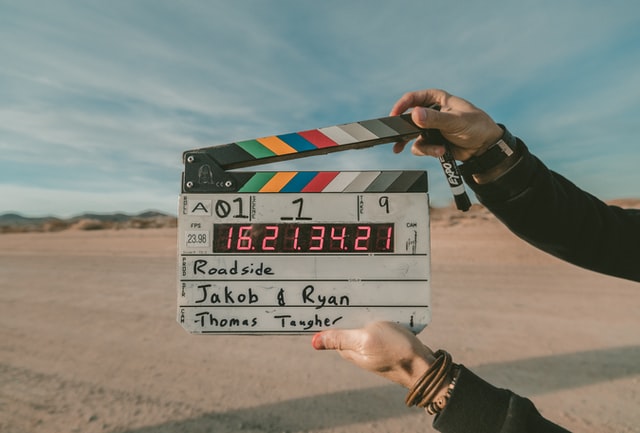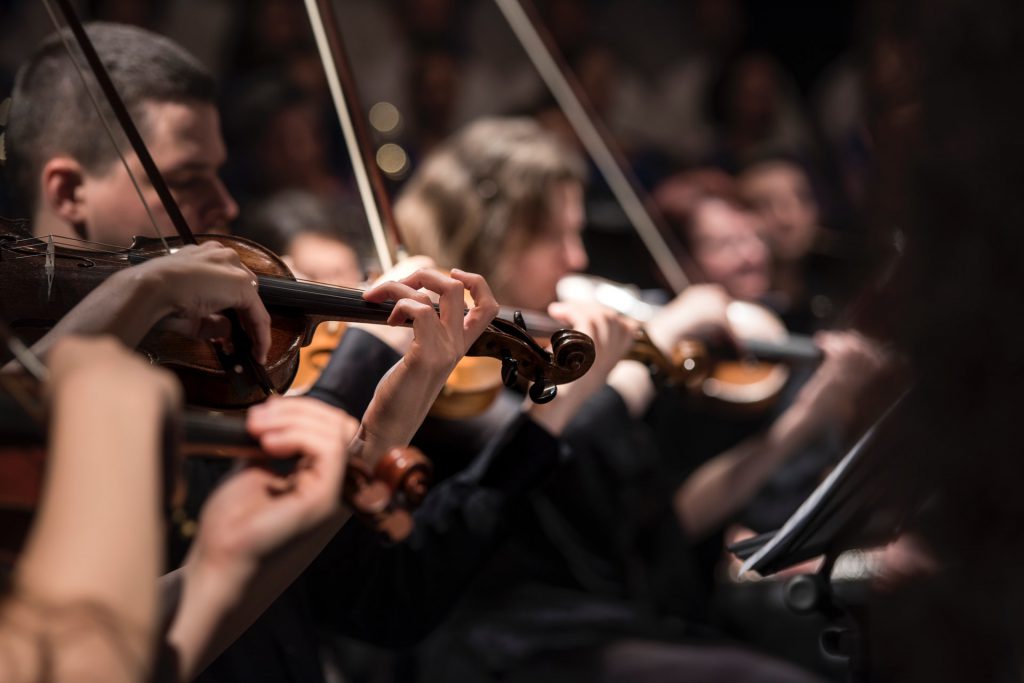National Film Score Day: Book and Film Score Pairings
Photo from @kostyadyadyun on Unsplash.
Ever listen to a song and think, “Oh, wouldn't this fit perfectly with this book?" Whether you associate a song with a specific character, world, or book scene, it’s easy to get as lost in music as it is in a great read, especially when it comes to film scores. Usually relying on instruments and non-lyrical choir harmonies, scores are composed solely for the purpose of a movie, and because of that, often have an underlying narrative that’s vague but powerful enough to elicit specific emotions. They’re dramatic and moving, and applicable to the characters and worlds we love.
That’s why for National Film Score Day, we’re pairing some of our favorite movie scores (we physically had to restrain ourselves from including at least three Hans Zimmer scores) with their fitting book match. Click each song title to give them a listen on YouTube!
Mud score (by David Wingo) with Matteo Alacrán series (by Nancy Farmer)
Although Wingo wrote Mud’s score to invoke the spirit of the American South, his assortment of string and percussion instruments — especially guitars, shakers, and piano — could effectively apply to Opium, Nancy Farmer’s fictional country between Aztlán (what we know as Mexico) and the United States from her books The House of the Scorpion and The Lord of Opium. Tracks like “Opening” have a mix of guitar and drum that sets up the emotion, action, and rustic atmosphere of Farmer’s world, and ones like “Juniper” utilize scattered piano to tell the viewer a bit more about the complicated character of Juniper from Mud, just like it could for ones like Tam Lin from the Matteo Alacrán series. The faster paced tracks like “Clinic” and “Snakebite” work well for more actiony book scenes of fear and escape, and “Ending” is perfect for the calm moments of self-discovery or tender interactions between Matt, Celia, Fidelito, and Matt’s other friends and confidants.
Buy the books:
The House of the Scorpion: Amazon | Barnes & Noble | Books A Million | Indiebound
The Lord of Opium: Amazon | Barnes & Noble | Books A Million | Indiebound
It (2017) score (by Benjamin Wallfisch) with The Southern Book Club’s Guide to Slaying Vampires (by Grady Hendrix)
It (2017) is adapted from the Stephen King novel, so sure, it has its perfect book match already, and Grady Hendrix’s The Southern Book Club’s Guide to Slaying Vampires is scheduled for a screen adaptation, so yeah, it’ll have its own score in due time, but these two were meant for each other (hint hint, PKM Productions). Wallfisch’s score manages to set your heart racing one moment and fluttering the next, and similarly Hendrix writes gruesome horror and blunt violence that physically makes you cringe while managing to include surprisingly heartwarming moments and fleshed-out characters you grow to love deeply. Wallfisch’s more chilling tracks like “Shapeshifter” plant seeds for the reader about shifty James Harris, and the building panic of “You’ll Die if You Try” could focus in on the less supernatural, but no less terrifying, horrors presented in the book. The hair-raising intensity of “Come Join the Clown, Eds” is great for shocking reveals, but Wallfisch’s score also features heartfelt tracks like “Blood Oath,” “Beverly,” and “Derry” that allow the reader to take a breath, focus on the characters and setting, and maybe even shed a tear or two.
Only a few more days until The Southern Book Club’s Guide to Slaying Vampires comes out! Preorder your copy to get it as early as publication date (Tuesday, April 7th).
Buy the book:
Amazon | Barnes & Noble | Books A Million | Indiebound
How to Train Your Dragon score (by John Powell) with the Railhead series (by Philip Reeve)
Yes, How to Train Your Dragon is already a series of books, but John Powell’s score for the movie is a fitting match for Philip Reeve’s YA sci-fi Railhead series. Powell’s soundtrack has the ability to transport listeners to a world with fantastical wonder and recognizable characters, struggles, and themes. Reeve does the same in his immersive tale of crotchety locomotives, AI deities, and loving androids. The large-scale adventure in tracks like “This is Berk,” “Test Drive,” and “Focus, Hiccup!” place the reader in the perfect place for a tale of train battles and planetary travel, and though the trains in the Railhead series aren’t steam-powered, the drums and iron-working noises in “Dragon Battle” help associate the story with the mechanical noises of the railroad cars they’ll be jumping to and from with Zen and Nova. “The Dragon Book” fluctuates between mysticism and danger, making it a great set up song for characters like Raven, and “Where’s Hiccup?” and “Forbidden Friendship” are touching songs that pair well with endearing moments between Zen and Nova.
Buy the books:
Railhead: Amazon | Barnes & Noble | Books A Million | Indiebound
Black Light Express: Amazon | Barnes & Noble | Books A Million | Indiebound
Station Zero: Amazon | Barnes & Noble | Books A Million | Indiebound
The Boy and the Beast score (by Masakatsu Takagi) with The Song of Seven (by Tonke Dragt)
You may have heard of Netflix’s recent adaptation of Tonke Dragt’s The Letter for the King, but have you heard of her other book, The Song of Seven? It’s a romping good time that Masakatsu Takagi’s The Boy and the Beast score would compliment well. The stories both hold a sense of lighthearted magic, adventure, and heroism that comes across in their colorful characters and contemporary setting with an otherworldly twist. In Dragt’s book, Frans often rides his bike through the village and woods, and if The Song of Seven were a movie, “Horizon” or “Awaken Hill” would be great tracks for those scenes. “Another Life” instills a quiet sense of mystery and awe that fits with the Seven Ways signpost and story, and for that sense of apartment living and school studying, there’s tracks like “Two Tomorrow” and “Free the Wind.” The bells, horns, and strings in “Attractive Force” and “Stray Boy” slowly grow in volume and speed like a ticking clock and remind listener’s of Frans’s nearing deadline to save his pupil Geert-Jan. Lastly, for wilder parts in Frans’s narrative, especially the climax, “The Beast Festivities” and “A Child Full of Life” invoke a sense of joyous celebration and a bit of comedy.
Buy the book:
Amazon | Barnes & Noble | Books A Million | Indiebound
Wendy score (by Benh Zeitlin & Dan Romer) with This Was Our Pact by Ryan Andrews
If you’re looking for a good ol’ fashion cry, then look no further than Zeitlin and Romer’s Wendy score and Ryan Andrews’s graphic novel, This Was Our Pact. Both capture the adventurous spirit of children, the longing for something more, and the bittersweetness of growing up, experiencing life, and making new memories. Both manage to fill your heart and fill your eyes (with tears, yes). “Straight On ‘till Morning,” “The Haunted Train,” and “Sneak Away” are great for daring escapades such as, you guessed it, Ben and Nathaniel’s sneaky getaway, and tracks featuring the mother tune, such as “Neverbirds” and “The Mother” would work well with Andrews’s breath-taking full spreads and scenic reveals. Now, for a bit of peace-filled tears, all you have to do is play “Counting the Days” as Ben and Nathaniel bike around hills and ride a gondola through the clouds. If that doesn’t work, listen to the percussive chime sounds of “To Grow Up is a Great Adventure” while Ben, Nathaniel, and the fisherbear float in a pool of stars.
Buy the book:
Amazon | Barnes & Noble | Books A Million | Indiebound
We Bought a Zoo score (by Jónsi) with The Astrology of You and Me by Gary Goldschneider
Another score that sounds as if you're amongst the stars is Jónsi’s We Bought a Zoo. These tracks are as beautiful and soothing to your ears as Gary Goldschneider’s The Astrology of You and Me is to your eyes. “Why Not?,” “We Bought a Zoo,” and “Sun” feature wordless chants and breaths, some sort of synthesized piano, light drums that resemble tip-toeing, and swelling strings that when put together parallel twinkling stars and the weightlessness of space. Give “Brambles,” “Humming,” and “Sink Ships” a listen for a more fabricated, muffled sound that’s just as spacey and perfect for a quiet journey of self-discovery with Goldschneider and the stars.
Buy the book:
Amazon | Barnes & Noble | Books A Million | Indiebound
Honorary Mention: The Haunting of Hill House score (by The Newton Brothers) with The End of Summer (by Tillie Walden)
The Haunting of Hill House may be a TV show, but the Newton Brothers’ score is too good a match for Tillie Walden’s The End of Summer that we had to mention it. Both the Newton Brothers’ score and Walden’s graphic novel are haunting, one in a more literal sense, and tell a paradoxical tale of communal isolation. With such heavy themes, either could have fallen into the categories of depressing music or story, but both manage to emphasize the good in life, like forgiveness, familiar love, or the soft touch of a giant therapy cat’s fur (that’s right). Any of the melancholic “Beginning of the End” movements fit well with The End of Summer’s secluded snowy landscape setting, and the piano melody and underlying tension in tracks like “Come Home” reflect the gothic architecture and growing friction in the family. Skip the straight-up spooky scores like “Darkness and Chaos,” and give “Whatever Walked There, Walked Alone” a play for a good summary of the expanse of the family castle and the mystery of the graphic novel’s narrative.
Buy the book:

Gabrielle Bujak
Gabrielle likes a lot of things and dislikes very little. Retired ice cream cake decorator, occasional farmhand, and reminiscing library worker, she spent her childhood dreaming of fighting fires and her college days writing about Bong Joon-ho before he was cool. Now, she preaches the importance of dental hygiene; chats up books, movies, and comics via the Quirk blog; and legally climbs silos. Whether the legality of the silo climbing makes her more or less interesting is up for debate. Email [email protected] if you want to review our titles or feature our authors.


















